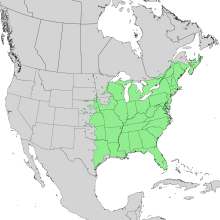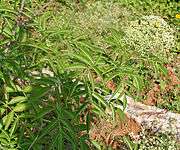Sambucus canadensis
Sambucus canadensis, the American black elderberry, Canada elderberry, or common elderberry, is a species of elderberry native to a large area of North America east of the Rocky Mountains, south to Bolivia.[3][2] It grows in a variety of conditions including both wet and dry soils, primarily in sunny locations.
| Sambucus canadensis | |
|---|---|
 | |
| Foliage and fruit | |
| Scientific classification | |
| Kingdom: | Plantae |
| Clade: | Tracheophytes |
| Clade: | Angiosperms |
| Clade: | Eudicots |
| Clade: | Asterids |
| Order: | Dipsacales |
| Family: | Adoxaceae |
| Genus: | Sambucus |
| Species: | S. canadensis |
| Binomial name | |
| Sambucus canadensis | |
 | |
| Natural range of Sambucus canadensis in the United States and Canada | |
| Synonyms[2] | |
|
Sambucus nigra subsp. canadensis (L.) Bolli | |
Description
It is a deciduous suckering shrub growing to 3 m or more tall. The leaves are arranged in opposite pairs, pinnate with five to nine leaflets, the leaflets around 10 cm long and 5 cm broad. In summer, it bears large (20–30 cm diameter) corymbs of white flowers above the foliage, the individual flowers 5–6 mm diameter, with five petals.
The fruit (known as an elderberry) is a dark purple to black berry 3–5 mm diameter, produced in drooping clusters in the fall.
 Flowers
Flowers Foliage
Foliage- Fruits
Taxonomy
It is closely related to the European Sambucus nigra. Some authors treat it as conspecific, under the name Sambucus nigra subsp. canadensis.[4]
Uses
The flower, known as elderflower, is edible, as well as the ripe berries when cooked. Other parts of the plant, such as leaves, stems, roots, seeds and unripe fruits, are toxic[5][6] due to the presence of cyanogenic glycosides, and alkaloids.[7] Because of the presence of cyanogenic glycosides in the seeds, the fruit should not be eaten raw in much quantity. Traditional methods of consuming elderberry includes jams, jellies, and syrups, all of which cook down the fruit and strain out the seeds.
Uses for the fruit include wine, jelly and dye. Leaves and inner bark can be used as an insecticide and a dye.[8] Leaves are also traditionally used in herbalism topically.
The genus name comes from the Greek word sambuce, an ancient wind instrument, in reference to the removal of pith from the twigs of this and other species to make whistles.[9][10]
References
- "NatureServe Explorer 2.0 - Sambucus nigra ssp. canadensis, Common Elderberry". explorer.natureserve.org. Retrieved 6 May 2020.
- "Sambucus canadensis". Germplasm Resources Information Network (GRIN). Agricultural Research Service (ARS), United States Department of Agriculture (USDA). Retrieved 26 December 2017.
- "Sambucus canadensis L." Plants of the World Online. Royal Botanic Gardens, Kew. Retrieved 6 June 2020.
- "Sambucus nigra". Integrated Taxonomic Information System.
- Peterson, Lee Allen (1977). Edible Wild Plants: Eastern/Central North America. Boston: Houghton Mifflin Company. p. 172. ISBN 0-395-92622-X.
- Preston, Richard J.; Braham, Richard R. (2002). North American Trees: Fifth Edition. Ames, Iowa: Iowa State Press. p. 199. ISBN 0-8138-1526-6.
- "Sambucus canadensis". North Carolina State Extension.
- "Sambucus canadensis". Plants for a Future.
- Niering, William A.; Olmstead, Nancy C. (1985) [1979]. The Audubon Society Field Guide to North American Wildflowers, Eastern Region. Knopf. p. 448. ISBN 0-394-50432-1.
- Little, Elbert L. (1980). The Audubon Society Field Guide to North American Trees: Eastern Region. New York: Knopf. p. 670. ISBN 0-394-50760-6.
